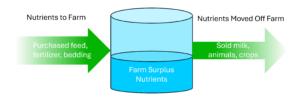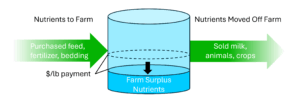Example Nitrogen Surplus Reduction Calculations
The FARM’N program pays producers for creditable reductions in total farm surplus.

A 300 acre farm has 100 lactating cows and culls 40 cows per year. The farm feed rations averaging 16% crude protein consisting of corn silage, corn grain, and commercial feed mix. The farm grows its own silage on 250 acres but imports alfalfa hay, corn grain, and commercial feed pellets. Milk production is 75lbs/d with a milk protein of 3.1%. All manure is land applied on the farm and the farm applies an additional 100 lbs of N/ac of commercial fertilizer.
| Nitrogen Imports | Nitrogen Exports | |||
| N in Purchased Feed | 34,500 lbs | N in Milk Sold | 11,160 lbs | |
| N in Purchased Fertilizer | 25,000 lbs | N in Cows Culled | 760 lbs | |
| Total | 59,500 lbs | Total | 11,920 lbs | |
The resulting Farm-level N surplus is calculated as 59,500 lbs - 11,920 lbs:
- Farm N Surplus: 47,580 lbs
In order to get paid for reductions in farm N surplus, your annual calculated N surplus will be compared with your baseline N surplus.  Suppose this farm can reduce total farm N surplus by 5,000 lbs. FARM'N pays $25 lbs of "creditable" surplus N reduced. Creditable N reductions are calculated as:
Suppose this farm can reduce total farm N surplus by 5,000 lbs. FARM'N pays $25 lbs of "creditable" surplus N reduced. Creditable N reductions are calculated as:
Creditable N Reduction = Reduction in N Surplus x Attenuation Factor x Delivery Factor
- The attenuation factor is the estimated amount of the N surplus that will eventually be lost to runoff. FARM'N assumes that 70% of the N applied on the farm is either taken up by plants, stored in soils or groundwater, or lost to the atmosphere.
- The delivery factor is the amount of N that leaves a farm that will reach priority waters. In priority watersheds like the Shenandoah Valley, the delivery factor is 1. In other areas, the delivery factor can be as low as 0.36. The delivery factor for unique locations can be found on the DEQ website.
Depending on the delivery factor, the creditable N reduction for this farm could range from 615 lbs to 1,500 lbs. For example:
- A farm in the Shenandoah Valley would be credited for 1,500 lbs of N reduction:
5000lbs N reduction x 0.3 attenuation x 1 delivery factor = 1,500 lbs - A farm in a non-priority watershed such as the James River would be credited for 615 lbs of N reduction:
5000lbs N reduction x 0.3 attenuation x 0.41 delivery factor = 615
For each farm, the calculated payment is $25/lb of creditable N reduction:
| Location | Shenandoah Valley | James River |
| Delivery Factor | 1 | 0.41 |
| Creditable N Reduction | 1,500 lbs | 615 lbs |
| Payment | $37,500 | $15,375 |
Below are a few examples showing how this farm might achieve reductions in N surplus.
Option 1: Increase N use efficiency by injecting manure and reducing fertilizer purchases
By injecting manure, more N is conserved and available for the crop, making it possible to reduce commercial N applications. The N Surplus Reduction, Creditable Reduction, and Payments associated with a Shenandoah Valley farmer reduce commercial N applications from 100 lbs of N per acre to a lower application rate are summarized below.
| Fertilizer N Applied Per Acre | N Surplus Reduction | Creditable Reduction | Payment |
| 100 | 0 | 0 | $0 |
| 95 | 1,250 | 375 | $9,375 |
| 90 | 2,500 | 750 | $18,750 |
| 80 | 5,000 | 1,500 | $37,500 |
| 60 | 10,000 | 3,000 | $75,000 |
Option 2: Reduce dietary crude protein
The farm will reduce dietary crude protein content by reducing reliance on the high-protein feed pellet currently utilized. This can be achieved by growing protein feeds on-farm or by formulating the concentrate portion of the diet to meet the amino acid needs of the cow. The N Surplus Reduction, Creditable Reduction, and Payments associated with a Shenandoah Valley farmer reducing dietary crude protein content through these mechanisms are summarized below.
| Concentrate CP % | N Surplus Reduction | Creditable Reduction | Payment |
| 18 | 0 | 0 | $0 |
| 17.5 | 537 | 161 | $4,026 |
| 17 | 1,074 | 322 | $8,052 |
| 16 | 2,147 | 644 | $16,104 |
| 15 | 3,221 | 966 | $24,156 |
Option 3: Increased herd longevity to decrease culling rates and heifer populations
The farm will retain lactating cows longer. Increased cow longevity means that the farm does not need to retain (and feed) as many yearlings and heifers on-farm. If the farm only culls fewer animals per year, it can support a lower population of yearlings and heifers. The N Surplus Reduction, Creditable Reduction, and Payments associated with a Shenandoah Valley farmer shifting heifer retention rates and cow culling rates are summarized below.
| Young Stock | Cows Culled | N Surplus Reduction | Creditable Reduction | Payment |
| 80 | 40 | 0 | 0 | 0 |
| 70 | 35 | 605 | 182 | 4,538 |
| 60 | 30 | 1,299 | 390 | 9,743 |
| 50 | 25 | 1,554 | 466 | 11,655 |
Summary
Flexibility is key. FARM’N producers can mix and match N surplus reduction strategies. Try one option or several options. Start with small changes, see how things go and make bigger changes later. The goal is to reduce the extra N in any way that makes (dollars and) sense for the farm.
